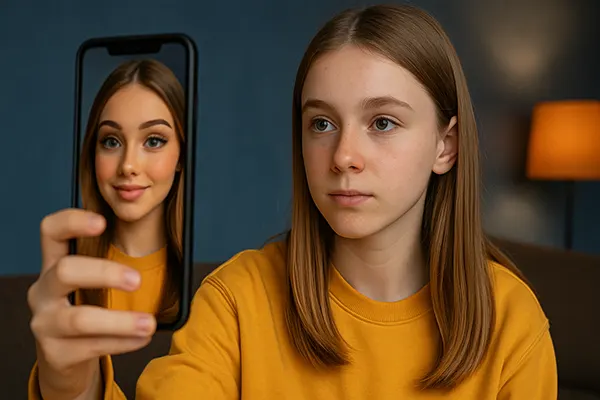
Social Engineering through AR Filters: A New Influence Tool on Teenagers
In 2025, augmented reality (AR) filters remain a staple of social media platforms like Instagram, Snapchat, and TikTok. Originally developed as a playful tool to modify appearances or environments in real time, AR filters have evolved into much more than digital entertainment. Their growing use among teenagers has revealed deeper implications — psychological manipulation, distortion of self-perception, and even potential grooming by malicious actors. This article explores how AR filters can serve as a subtle, yet powerful tool of social engineering, especially targeting the minds of minors.
Visual Distortion and the Crisis of Appearance Ideals
AR filters can drastically alter facial features: smoothing skin, enlarging eyes, narrowing noses, changing hair colour — all in a split second. For teens navigating identity formation, this often sets unattainable standards of beauty. Many begin to see their unfiltered faces as “lesser,” leading to dissatisfaction, body dysmorphia, or even a desire for cosmetic procedures at increasingly younger ages.
Multiple psychological studies have now linked excessive use of face-modifying AR filters with increased levels of anxiety and self-esteem issues in adolescents. These digital masks blur the line between reality and artificial perfection. What begins as harmless fun can morph into an internalised demand for perfection that no real-world mirror can reflect.
Moreover, algorithms often push popular filters based on mainstream beauty norms, reinforcing stereotypes and reducing the diversity of acceptable self-image. Rather than encouraging self-acceptance, AR filters often encourage self-correction — and that mindset sticks.
Brands and Manipulators Exploiting Teen Vulnerability
Marketing teams have long used beauty ideals to sell products, but with AR filters, they now embed those ideals directly into the user’s appearance. Some beauty brands release branded filters that subtly promote a certain product or idealised look — often without clear labelling. Teens may not realise they’re interacting with advertising at all.
Beyond brands, the darker side of influence has emerged. Extremist groups, sects, or online predators have experimented with AR-enhanced content to create appealing personas. Filters help conceal identities while building emotional connections — particularly with vulnerable teens who equate filtered attractiveness with trustworthiness or popularity.
AR filters thus become a masking tool for manipulation. Teenagers, already susceptible to peer pressure and appearance validation, are prime targets for individuals seeking to control or influence behaviour through emotional or ideological grooming.
Risks for Minors: Identity, Consent, and Psychological Impact
At the core of the issue lies consent — both digital and psychological. Teenagers often use AR filters without understanding how these tools affect their self-image or how their data and visual behaviour might be tracked and analysed. With AI-driven analytics becoming more advanced, companies and third parties can profile teens based on filter usage patterns, emotional responses, and interaction time.
This profiling opens doors to targeted persuasion. Algorithms might begin recommending content that reinforces distorted ideals, leading teens further down a rabbit hole of curated digital identity. Without meaningful digital literacy education, most young users are unaware of how deep the manipulation can go.
Moreover, minors often use filters in emotionally vulnerable moments — when alone, stressed, or seeking approval. These digital masks amplify vulnerability instead of offering empowerment. Emotional dependency on a filtered self can interfere with healthy emotional development, identity formation, and self-acceptance.
The Role of Educational and Government Campaigns
Some governments and NGOs have already initiated awareness campaigns targeting AR filter literacy in schools. The UK, Germany, and the Netherlands have started incorporating “digital beauty” lessons into secondary education, aiming to equip teens with critical thinking tools for understanding what they see — and what they post.
However, private sector accountability is also essential. Social media companies must label filters clearly, include psychological impact warnings, and provide parental control tools. Without transparency from tech companies, educational initiatives alone cannot stem the tide of influence.
Furthermore, partnerships between schools, psychologists, and social platforms could lead to better educational material and digital well-being tools — such as prompts reminding users when a filter is active or how much time they’ve spent with it enabled.

Developing a More Resilient Generation of Digital Citizens
To tackle the influence of AR filters as a tool of social engineering, society must foster resilience and digital self-awareness in teenagers. This goes beyond banning filters or limiting access — it requires long-term investment in mental health, media literacy, and online ethics education.
Parental involvement plays a vital role. Conversations at home about appearance, identity, and online influence help contextualise what teenagers experience online. Parents must also be educated about the psychological risks of AR filters — many of which are subtle but cumulative over time.
Above all, teens need safe spaces where authenticity is celebrated rather than filtered out. Alternative platforms or communities that value realism over aesthetic enhancement can act as a counterbalance to the endless scroll of perfection. Empowering youth to create content, rather than just consume it, builds confidence and autonomy.
Looking Ahead: Regulation, Research, and Responsibility
As AR filter technology continues to advance, research must keep pace. Ongoing studies into the psychological effects of real-time facial modification should be prioritised by universities and public health agencies. Without data, regulation will be slow and reactive.
Regulatory bodies could consider age restrictions, clearer labelling standards, and enforced transparency for all filter-producing accounts. This includes influencers and brands, who often introduce filters to mass audiences without disclosing their origin or intention.
Finally, responsibility lies with us all — educators, parents, developers, and policymakers. AR filters, like any tool, are not inherently harmful. But in the wrong hands or with unchecked use, they can become subtle agents of manipulation. Recognising this risk is the first step toward building a safer digital environment for the next generation.
